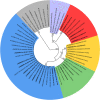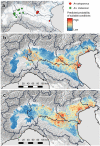Mosquitoes of the Maculipennis complex in Northern Italy
- PMID: 33742019
- PMCID: PMC7979756
- DOI: 10.1038/s41598-021-85442-9
Mosquitoes of the Maculipennis complex in Northern Italy
Abstract
The correct identification of mosquito vectors is often hampered by the presence of morphologically indiscernible sibling species. The Maculipennis complex is one of these groups that include both malaria vectors of primary importance and species of low/negligible epidemiological relevance, of which distribution data in Italy are outdated. Our study was aimed at providing an updated distribution of Maculipennis complex in Northern Italy through the sampling and morphological/molecular identification of specimens from five regions. The most abundant species was Anopheles messeae (2032), followed by Anopheles maculipennis s.s. (418), Anopheles atroparvus (28) and Anopheles melanoon (13). Taking advantage of ITS2 barcoding, we were able to finely characterize tested mosquitoes, classifying all the Anopheles messeae specimens as Anopheles daciae, a taxon with debated rank to which we referred as species inquirenda (sp. inq.). The distribution of species was characterized by Ecological Niche Models (ENMs), fed by recorded points of presence. ENMs provided clues on the ecological preferences of the detected species, with An. daciae sp. inq. linked to stable breeding sites and An. maculipennis s.s. more associated to ephemeral breeding sites. We demonstrate that historical Anopheles malaria vectors are still present in Northern Italy.
Conflict of interest statement
The authors declare no competing interests.
Figures




Similar articles
-
Integrated taxonomy to advance species delimitation of the Anopheles maculipennis complex.Sci Rep. 2024 Dec 28;14(1):30914. doi: 10.1038/s41598-024-81767-3. Sci Rep. 2024. PMID: 39730578 Free PMC article.
-
Distribution of Anopheles daciae and other Anopheles maculipennis complex species in Serbia.Parasitol Res. 2018 Oct;117(10):3277-3287. doi: 10.1007/s00436-018-6028-y. Epub 2018 Aug 28. Parasitol Res. 2018. PMID: 30155566 Free PMC article.
-
Species composition, geographical distribution and seasonal abundance of the Anopheles maculipennis complex along the Upper Rhine, Germany.Parasitol Res. 2020 Jan;119(1):75-84. doi: 10.1007/s00436-019-06551-z. Epub 2019 Dec 12. Parasitol Res. 2020. PMID: 31832758
-
Geometric morphometrics and machine learning as tools for the identification of sibling mosquito species of the Maculipennis complex (Anopheles).Infect Genet Evol. 2021 Nov;95:105034. doi: 10.1016/j.meegid.2021.105034. Epub 2021 Aug 9. Infect Genet Evol. 2021. PMID: 34384936
-
The Anopheles maculipennis complex (Diptera: Culicidae) in Germany: an update following recent monitoring activities.Parasitol Res. 2016 Sep;115(9):3281-94. doi: 10.1007/s00436-016-5189-9. Epub 2016 Jul 22. Parasitol Res. 2016. PMID: 27444437 Review.
Cited by
-
Distribution and abundance of Aedes caspius (Pallas, 1771) and Aedes vexans (Meigen, 1830) in the Po Plain (northern Italy).Parasit Vectors. 2024 Nov 5;17(1):452. doi: 10.1186/s13071-024-06527-8. Parasit Vectors. 2024. PMID: 39501400 Free PMC article.
-
New Cytogenetic Photomap and Molecular Diagnostics for the Cryptic Species of the Malaria Mosquitoes Anopheles messeae and Anopheles daciae from Eurasia.Insects. 2021 Sep 17;12(9):835. doi: 10.3390/insects12090835. Insects. 2021. PMID: 34564275 Free PMC article.
-
Barcoding of Italian mosquitoes (BITMO): generation and validation of DNA barcoding reference libraries for native and alien species of Culicidae.Parasit Vectors. 2024 Sep 28;17(1):407. doi: 10.1186/s13071-024-06478-0. Parasit Vectors. 2024. PMID: 39342262 Free PMC article.
-
Integrated taxonomy to advance species delimitation of the Anopheles maculipennis complex.Sci Rep. 2024 Dec 28;14(1):30914. doi: 10.1038/s41598-024-81767-3. Sci Rep. 2024. PMID: 39730578 Free PMC article.
-
Characterization of environmental drivers influencing the abundance of Anopheles maculipennis complex in Northern Italy.Parasit Vectors. 2024 Mar 6;17(1):109. doi: 10.1186/s13071-024-06208-6. Parasit Vectors. 2024. PMID: 38449059 Free PMC article.
References
-
- Kettle, D.S. Medical and Veterinary Entomology 2nd edn (CAB International, 1995).
-
- Falleroni D. Fauna anofelica italiana e suo “habitat” (paludi, risaie, canali). Metodi di lotta contro la malaria. Riv. Malariol. 1926;5:553–559.
-
- Severini F, Toma L, Di Luca M, Le RR. Zanzare Italiane: generalità e identificazione degli adulti (Diptera, Culicidae) Fragmenta Entomologica. 2009;41(2):213–372. doi: 10.4081/FE.2009.92. - DOI
-
- Manguin, S. et al. Biodiversity of Malaria in the World (John Libbey Eurotext, 2008).
Publication types
MeSH terms
LinkOut - more resources
Full Text Sources
Other Literature Sources
Medical

